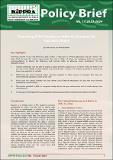| dc.description.abstract | Tourism is a critical sector in the country’s economy,
contributing to nearly 10.4 per cent of Kenya’s GDP.
The share of employment in tourism sector, notably
in accommodation and food services sector activities,
was 23 per cent in 2022. The ASALs make up to 89 per
cent of the country land area. The region possesses
a competitive edge in the tourism industry particularly
given its comparative advantage in form of tourism
resource endowment. However, the ASALs’ immense
potential, notably in tourism, has not been fully exploited
for decades. The main contributing factors include the
regions having been associated with issues of cattle
rustling, drought, instability, and poverty, among others.
ASALs are home to 90 per cent of the wildlife that
sustains the tourism sector and most of the attraction
sites such as game reserves and national parks are in
ASAL regions. However, the coastal beach remains the
most preferred destination for tourists. ASALs record
the lowest inbound visitors annually compared to other
regions. Northern Kenya has the lowest hotel bed
occupancy rate of 4.9 per cent. | en |

